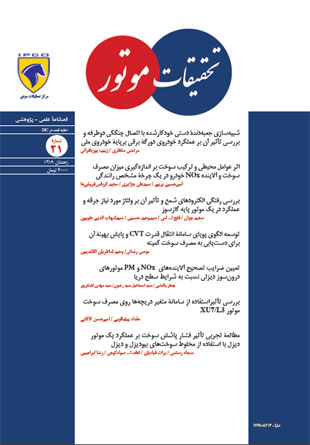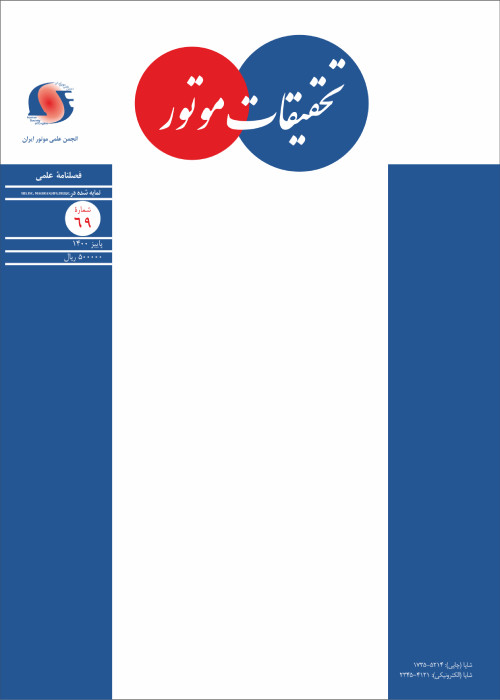فهرست مطالب

نشریه تحقیقات موتور
پیاپی 21 (زمستان 1389)
- تاریخ انتشار: 1389/11/19
- تعداد عناوین: 7
-
-
صفحه 13در این مقاله به بررسی اثر عوامل محیطی شامل دما، فشار و رطوبت و همچنین تغییر ترکیب سوخت بر مصرف مخصوص سوخت موتور و مصرف سوخت خودرو و همچنین میزان انتشارآلاینده های اکسید های نیتروژن پرداخته شده است. شبیه سازی به کمک نرم افزار شبیه ساز موتور GT-Power انجام شده است. نقاط کاری انتخابی برای شبیه سازی در این مطالعه همواره در بارهای جزیی است که اکثرا در چرخه رانندگی بیشترین تکرارپذیری را دارند و نوع سوخت مصرفی گاز طبیعی بوده است. شبیه سازی تغییر فشار محیط، با سوخت بنزین نیز انجام پذیرفته است. موتور انتخابی برای شبیه سازی موتور EF7.1.7.NA است. الگوی شبیه سازی مبنا ابتدا با داده های تجربی در بارهای جزیی با دقت کافی زینه بندی شده است. همچنین برای بررسی اثر تغییر فشار محیط، آزمونی بر روی موتور انجام پذیرفت که نتایج آن با شبیه سازی تطابق خوبی دارد و نیز استانده ای که در زمینه آزمون اندازه-گیری مصرف سوخت و آلایندگی خودرویی وجود دارد با نتایج حاصل از شبیه سازی مقایسه گردیده است.
کلیدواژگان: مصرف مخصوص، آلاینده اکسیدهای نیتروژن، رطوبت نسبی، موتور گازسوز، ترکیب سوخت -
صفحه 21در این تحقیق ابتدا تاثیر هندسه الکترودها بر ولتاژ مورد نیاز جرقه و عملکرد یک موتور پایه گازسوز، با استفاده از سه نوع شمع که دارای هندسه متفاوت الکترودها و وضعیت حرارتی یکسان می باشند، مورد بررسی قرار می گیرد؛ سپس با انجام آزمون های دوام موتوری، وضعیت دوام شمع ها بررسی می شود. جهت بررسی ساز وکارهای رفتگی الکترودها، از روش سطح نگاری با کمک میکروسکوب الکترونی روبشی (SEM) استفاده شده است؛ همچنین جهت بررسی وضعیت جرقه زنی شمع ها از آزمون قطعه ای شمع بهره برده شده است. نهایتا با انجام آزمون های احتراقی، تاثیر رفتگی الکترودها بر ولتاژ مورد نیاز جرقه، عملکرد و مصرف سوخت موتور مورد ارزیابی قرار می گیرد. بر اساس نتایج به دست آمده برای شمع های نو، استفاده از شمعی که در الکترود منفی خود شیار دارد، سبب کاهش 21 درصدی بیشینه ولتاژ مورد نیاز می شود. بر اساس نتایج آزمون های دوام، پس از 200 ساعت کارکرد، میانگین افزایش دهانه برای الکترودهای پایه نیکل، 7 برابر بیشتر از الکترودهای پلاتینی است. بررسی سطح الکترودها به کمک SEM، ترک ها و حفره های زیادی را در سطح الکترودهای پایه نیکل نشان می دهد. ایجاد و رشد ترک ها و نفوذ اکسید کلسیم می تواند سبب افزایش نرخ رفتگی در الکترودهای پایه نیکل شود. بر اساس نتایج آزمون احتراقی، در صورت تامین ولتاژ مورد نیاز جرقه توسط سیم پیچ افروزش، رفتگی الکترودها تاثیر قابل ملاحظه ای در میزان گشتاور و مصرف سوخت ویژه موتور در هنگام کارکرد با سوخت گاز طبیعی ندارد.
کلیدواژگان: شمع، رفتگی الکترود، آزمون دوام، ولتاژ مورد نیاز جرقه، عملکرد موتور -
صفحه 58با توجه به بحران جهانی سوخت و لزوم استفاده از موتورهایی با کارایی بالاتر و مصرف سوخت کمتر راهکارهای متنوعی جهت کاهش مصرف سوخت و افزایش کارایی موتورهای احتراق داخلی ارائه شده است درکشور ما نیز جهت نیل به این مقصود قوانین و استانداردهای مختلفی مصوب شده است.از آنجاکه موتور XU7/L3 محصول شرکت پژو دومین موتور پرتیراژداخلی سازی شده کشور می باشد، این موتور به عنوان موتور مورد مطالعه در این تحقیق انتخاب شده است. یکی از متدهای کاهش مصرف سوخت قابل بکارگیری در این موتور استفاده از سیستم متغیر سوپاپهاست که در هر دور با توجه به شرایط کارکرد موتور زمان باز و بسته شدن سوپاپها را تغییر داداه موجب بهبود راندمان حجمی و در نتیجه کاهش مصرف سوخت و افزایش کارایی موتور می گردد. در این تحقیق در ابتدا کلیه اجزای موتور XU7/L3 اعم از مانیفولدهای ورودی و خروجی و مسیر اگزوز در نرم افزار GT-Power مدل شده. در مرحله بعد مدل تهیه شده درنرم افزار GT-Power با نرم افزار MATLAB Simulink برای کنترل روی ورودی ها و خروجی ها کوپله شده است.سپس با ارائه توابع هدف مناسب سعی می شود مصرف سوخت ویژه ترمزی موتور با اتخاذ مناسب ترین زمان بندی برای سوپاپهای ورودی و خروجی بهینه می شود و بدینوسیله امکان پذیری رسیدن به حداکثر کاهش مصرف سوخت و حداقل مصرف سوخت قابل دسترس با تغییر زمان بندی سوپاپها به همراه زمان بندی بهینه محاسبه میشود. همچنین در این تحقیق راهکار نوین طرح شده در تحقیقات قبلی توسط مولفان جهت بهینه سازی مدل GT-Power یک موتور احتراق داخلی با استفاده از روش آنالیز حساسیت در مطالعات قبلی ارائه شده بود تکمیل و مورد بررسی دقیق تر قرار گرفت.کلیدواژگان: GT، Power، MATLAB Simulink، آنالیز حساسیت، سیستم متغیر سوپاپها، مصرف سوخت ویژه ترمزی، زمان بندی سوپاپها
-
صفحه 73بیودیزل، یک سوخت جایگزین برای استفاده در موتورهای دیزل است. با توجه به تفاوت های زیادی که بین سوخت بیودیزل و دیزل وجود دارد، برای عملکرد بهینه یک موتور با هرکدام از این سوخت ها یا مخلوط های مختلف آن ها، حتی الامکان باید بعضی از شرایط کاری موتور را تغییر داد. در این تحقیق، عملکرد یک موتور دیزل پاشش مستقیم با سوخت بیودیزل بررسی شده است. روش انجام تحقیق به این ترتیب است که آزمایش های مختلفی بر روی یک موتور دیزل با استفاده از مخلوط های مختلف سوخت های بیودیزل و دیزل در دورهای 1200، 1600، 2000 و 2400 دور بر دقیقه انجام شد. در جریان آزمایش ها، فشار پاشش سوخت به درون استوانه به میزان 185، 200 و 215 بار تنظیم شد. نتایج گشتاور و مصرف ویژه سوخت ترمزی برای سوخت های B20، B40 و B100 در شرایط مختلف دور موتور و فشار پاشش یادداشت و مقایسه شدند. نتایج تحقیق نشان داد که افزایش فشار پاشش سوخت برای سوخت های B20، B40 و B100 به ترتیب باعث افزایش گشتاوری معادل 9/4%، 5/6% و 1/8% و کاهش بیشینه مصرف ویژه سوخت ترمزی معادل 12%، 6/12% و 2/9% می شود. همچنین، با افزایش فشار پاشش دمای گازهای خروجی از مجرای دود و بیشینه فشار درون استوانه موتور افزایش یافت.
کلیدواژگان: سوخت بیودیزل، موتور دیزل، فشار پاشش سوخت، عملکرد موتور
-
Page 13In this article effect of ambient condition including temperature, pressure and humidity and also variation of fuel composition on engine specific fuel consumption and fuel consumption of vehicle and also nitrogen oxides has been investigated. Simulation has been done by engine cycle simulator GT-Power. Selected working points for simulation in this research are all in part load and in driving cycle are repeated high and consumption fuel is CNG. Selected engine for simulation is EF7.1.7NA. Base simulation model, validated by experimental part load data with sufficient precision. Also for investigating effect of ambient pressure variation, a test has been done on engine that results shows acceptable adjusting with simulation. Also vehicle fuel consumption and NOx emission standard is compared with results of simulation.
-
Page 21In this research, the effect of electrode's configuration on the required voltage and performance of a natural gas fuel base engine is investigated using three types of spark plugs with the same heat range and different electrode's configuration. Then, durability of spark plugs is investigated in durability tests. Scanning electron microscope (SEM) is used to study mechanisms of electrode erosion. Also, sparking quality of spark plugs has been investigated by spark plug test rig. Finally, the effects of electrode erosion on the required voltage, performance and fuel consumption of engine will be investigated during combustion test. According to the results of new spark plugs, groove in ground electrode causes to 21% decline in required voltage. Considering results of durability tests, after 200 hours test, average of gap growth for nickel based electrodes seven times higher than platinum electrodes. SEM analysis of electrode's surface indicates many cracks and craters on the surface of nickel based electrodes. Initiation and growth of cracks and intrude of calcium oxide could lead to accelerate erosion of nickel based electrodes. Results of combustion test shows that if ignition coil could supply required voltage, electrode's erosion would not considerable effect on the amount of torque and brake specific fuel consumption (BSFC) of engine in operation with CNG.
-
Page 48The ambient thermodynamic properties (such as pressure, temperature, and humidity) are functions of altitude, and climate situations, which affect the density and physical conditions of air. On the other hand, the performance and emission standards of internal combustion engines have been enacted for sea level conditions. Therefore, a major problem of performance test and emission is the lack of standard sea level situation (such as temperature, pressure, and humidity) in the test place. In this paper, a system was build up to provide the desired properties of inlet air from combustion point of view, namely pressure, temperature, and humidity. Then, the emission tests (including 8 modes and 13 modes) in different thermodynamic conditions of inlet air, on five prototype diesel engines were conducted. Finally, a correlation between the engine pollutants (i.e. PM and NOx) and inlet air thermodynamic properties was obtained in which the correction factors for NOX and PM were attained. Regarding the large number of performed tests for insuring the accuracy of results, by the aid of error analysis the reliability range of correction factors were determined.
-
Page 58Considering the world fuel crisis and need for more efficient internal combustion engines different fuel consumption reduction methods has been developed. For this purpose several law and standards has been adopted in our country. In this study XU7/L3 engine is one of Peugeot products which is Iran's second most produced engine has been chosen as case study. Using variable valve timing is one of fuel consumption reduction methods that can be applied to the engine, in this method depending on engine operation condition, inlet and exhaust valve timing change to enhance volumetric efficiency, fuel economy and engine performance. In first part of the study all parts of the engine were modeled in GT-Power software, in next stage GT-Power was coupled with SIMULINK MATLAB which controls the input and output parameters. Putting forward a suitable target function for brake specific fuel consumption (BSFC) optimum valve timing for the engine was calculated for best fuel economy. And maximum achievable fuel economy using variable valve timing in the engine was calculated. In the study newly invented method for model optimization in previous studies was completed.
-
Page 73Biodiesel is an alternative fuel for diesel engine. Considering the differences between diesel and biodiesel fuels, engine condition should be modified based on the fuel or fuel blends to achieve optimum performance. In this study, performance of a diesel engine using biodiesel was investigated. Different experiments were carried out on a diesel engine using different blends of diesel and biodiesel fuels choosing speeds of 1200, 1600, 2000, and 2400 rpm. During experiments, the fuel injection pressure into cylinder was regulated on 185, 200 and 215 bar. The results of torque and brake specific fuel consumption for fuel blends of B20, B40, and B100 in different engine speeds and injection pressures were recorded and compared. The results of this research work showed that increasing fuel injection pressure for fuel blends of B20, B40, and B100 increased torque about 4.9%, 6.5% and 8.1% respectively and decreased maximum brake specific fuel consumption about 12%, 12.6% and 9.2% respectively. Also, the exhuast gas temperature and peak pressure of cylinder were increased by increasing the injection pressure.


